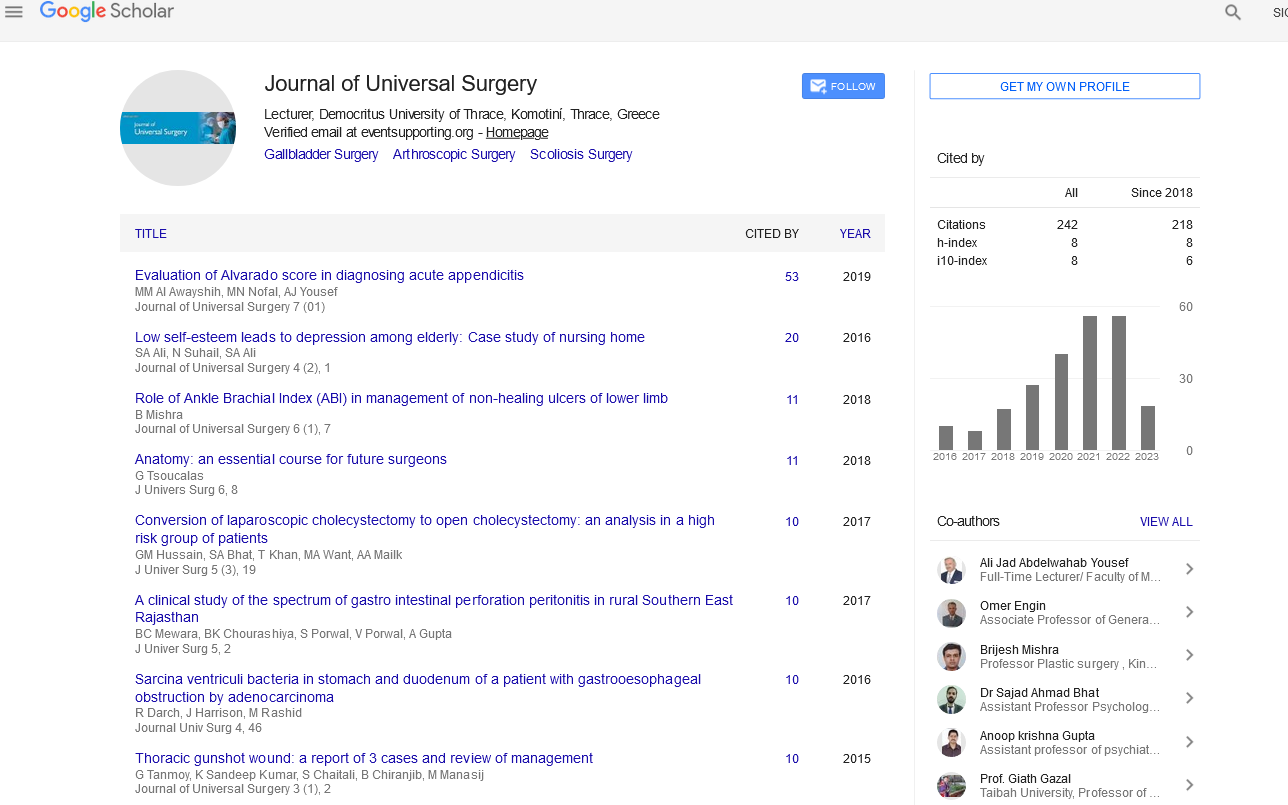Perspective - (2024) Volume 12, Issue 3
Success Rate of Varicose Vein Surgery
Deacon Jhonathan*
Department of General Surgeon, Unversity of Lytton, Lytton, Canada
*Correspondence:
Deacon Jhonathan, Department of General Surgeon, Unversity of Lytton, Lytton,
Canada,
Email:
Received: 15-May-2024, Manuscript No. IPJUS-24-14849;
Editor assigned: 20-May-2024, Pre QC No. IPJUS-24-14849 (PQ);
Reviewed: 03-Jun-2024, QC No. IPJUS-24-14849;
Revised: 24-Jun-2024, Manuscript No. IPJUS-24-14849 (R);
Published:
27-Jun-2024
Introduction
Each year, more than 42,000 patients in the English National
Health Service (NHS) have elective varicose vein surgery. A
satisfactory outcome is typically determined solely by a clinical
examination performed during a later follow-up appointment;
official patient opinions are rarely assessed. This is expected to
change, though, as the NHS develops a competitive internal
market that requires providers to prove the value of their
services in order to get funding from purchasers. Any measure of
effectiveness for operations like varicose vein surgery that are
performed primarily to improve quality of life should include the
patient's assessment of the result.
A self-completed questionnaire was used to survey patients
before, one month, and six months operation. Clinical data
regarding the patients was obtained from their medical records.
The survey consisted of five modified versions of the SF-36
questionnaire, as well as inquiries specifically related to
symptoms of varicose veins.
Description
The responses to the SF-36 scale questions were utilized to
determine the eight scores as percentages. A higher score on
each scale indicates better health, while a lower score indicates
poorer health. The seven questions pertaining to symptoms
were formulated in a similar manner to the SF-36 questions.
Using a 5-point scale ranging from "not at all" to "extremely,"
patients were asked to indicate the extent to which they had
been bothered by various symptoms associated with their
varicose veins over the past month. These symptoms included: i.
pain or aching; ii. throbbing; iii. tiredness; iv. appearance; v. skin
problems (itching or rashes); vi. swelling; and vii. ulcers. A score
was calculated using the same method employed for the SF-36
scores. In addition to the questionnaire, patients were also
asked supplementary questions regarding any other diseases or
conditions they may have had. Furthermore, they were asked
about their occupation prior to the operation and evaluated the
success of the procedure at the 6-month mark.
One hundred and thirty-one patients (87%) returned the
preoperative questionnaire, with no significant differences in
age or gender between those who responded and those who did
not. Thirty-five patients underwent a day case procedure, while
the remaining stayed in the hospital for 1 to 3 days. Fifty-five patients (42%) had their left leg operated on, 41 (31%) the right
leg, and 34 (26%) both legs. The side was not specified in one
case. Twenty-eight patients (21%) reported that it was not their
first varicose vein operation. Out of 165 varicose vein
operations, all involved vein avulsion, with most also
undergoing another procedure such as long saphenous vein
ligation (105), short saphenous vein ligation (15), or above
knee strip.
Patients who underwent varicose vein surgery exhibited similar
scores to the standard population on most dimensions.
However, when it came to General Health Perception, varicose
vein patients scored significantly higher, while their scores on
Pain were significantly lower. The majority of patients fell into
categories that were considered medically minor, with 29%
reporting no pain at all and 32% experiencing no physical
limitations. Only a small percentage (6%) of patients had ulcers.
This finding contrasts with a study conducted by Garrett et al.,
where varicose vein patients scored significantly lower than the
general population on various parameters.
After the surgery, the general health of these patients did
improve, particularly in the areas of physical function, energy,
and pain, with a change magnitude of approximately 0.4
standard deviations. It is worth noting that although the SF-36
health survey questionnaire has been deemed suitable for use in
busy clinical settings, this is the first time it has been utilized for
a surgical procedure in the U.K. In this regard, the questionnaire
was found to be user-friendly, as patients had no difficulty
completing it. However, there were challenges in maintaining
compliance, despite reminders.
The patients enrolled in this research exhibited excellent
health prior to the operation, with more than half of them
achieving a perfect score of 100% on three dimensions of SF-36,
making it impossible for them to show any improvement.
Consequently, SF-36 demonstrated lower sensitivity to changes
following treatment compared to what would have been
observed in a less healthy patient population. While none of the
participants scored the maximum preoperative score on
symptom-specific questions, a significant improvement was
noted postoperatively.
Conclusion
Nevertheless, an essential characteristic of any generic health
assessment questionnaire is its ability to provide comparable
results across different health conditions. The overall good
health status of individuals suffering from varicose veins may
explain why their treatment is often considered a lower priority when faced with more pressing medical needs. Nonetheless, the
substantial enhancement in symptoms and general health that
can be achieved through relatively straightforward surgical
interventions for a large number of individuals suggests that,
despite any opposing views, these procedures do hold a valid
position in the realm of surgery.
Citation: Jhonathan D (2024) Success Rate of Varicose Vein Surgery. J Univ Surg Vol.12 No.3: 022.





